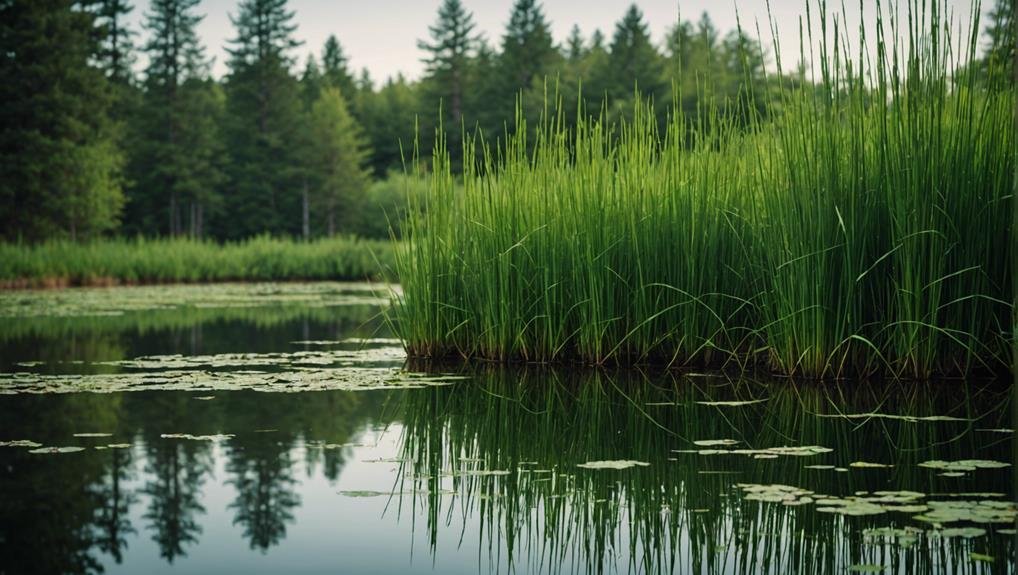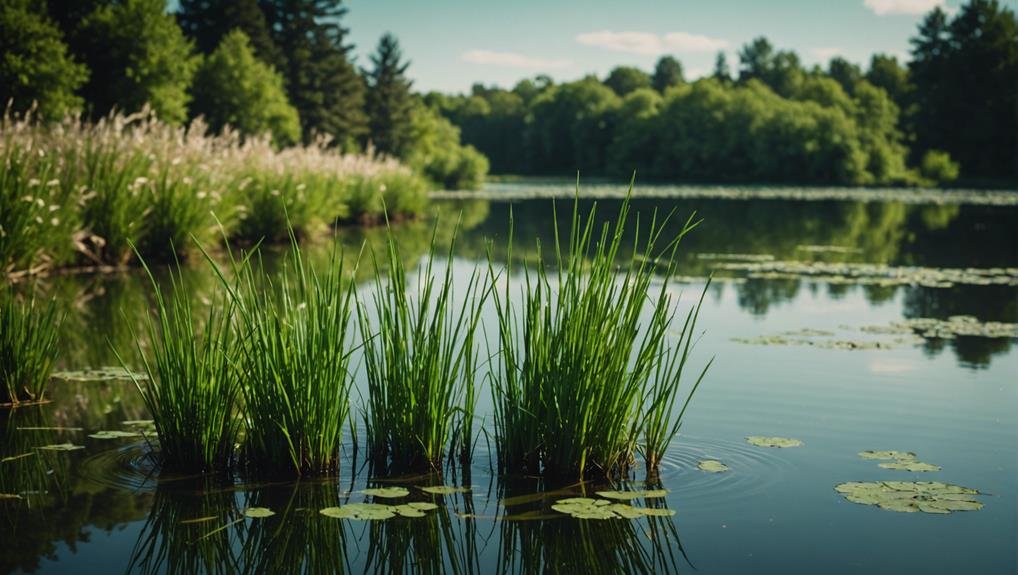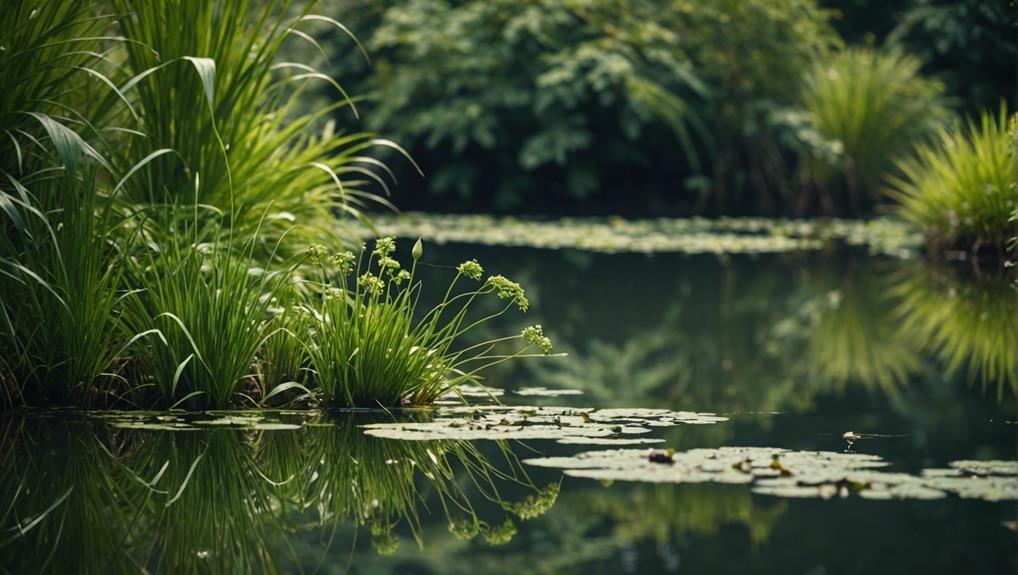When planting around your pond, consider incorporating robust grasses like cattails and bulrushes. These plants thrive in wetland environments, enhancing the beauty of your water garden while providing habitats for wildlife. Manna grasses and sweet flag are excellent choices for adding visual appeal and supporting local fauna. Horsetail and common rush are known for their vigorous growth and ecological benefits, contributing to a balanced ecosystem. Papyrus and reeds play vital roles in water purification and creating habitats for various species. Rushes and sedges help control soil erosion and promote overall ecosystem health, with unique varieties like Tussock sedge adding a touch of visual interest. Native to North America, woodoats are adaptable and low-maintenance, making them ideal for various planting conditions. Explore the possibilities of optimizing your pond ecosystem with these top-performing grasses.
Some of the links in this article may be affiliate links. If you make a purchase through these links, we may earn a small commission at no extra cost to you. Thank you.
Cattails and Bulrushes
Often found near ponds and wetlands, cattails (Typha spp.) and bulrushes (Schoenoplectus spp.) are crucial plants for creating dynamic and balanced water gardens. These plants thrive in wetland environments, playing a significant role in aquatic ecosystems. Cattails, native to North America and Europe, boast bright green leaves and can be contained in pots for controlled growth. Bulrushes, recognized by their cylindrical stems and small clusters of flowers, can be found worldwide along water edges. Both species are essential for native plantings and stabilizing shorelines, providing nesting spots for birds and shelter for aquatic creatures. Moreover, bulrushes are effective in managing pollution, making them invaluable for maintaining healthy and sustainable water habitats.
Manna Grasses and Sweet Flag
Adding to the variety of pond plants, manna grasses (Glyceria spp.) and sweet flag (Acorus spp.) bring their unique charm to water gardens with their upright leaves and diverse options. Manna grasses are found worldwide, thriving in moderate climates with nutrient-rich, consistently moist soil. Sweet flag, suitable for USDA zones 6-9, thrives in warm, humid conditions and offers variegated and dwarf variations. These plants not only enhance the beauty of ponds but also provide a habitat for wildlife.
For maintenance, regular trimming is recommended to prevent overgrowth, along with monitoring water levels. Landscaping enthusiasts can use sweet flag as a border plant and incorporate manna grasses in deeper pond areas for a visually appealing, textured effect.
Horsetail and Common Rush

Horsetail, also known as Equisetum hyemale, and Common Rush, or Juncus effusus, are two pond plants celebrated for their strong growth and ecological benefits. Horsetail, originating from Northern Asia, Europe, and North America, can reach heights of up to 6 feet and bears a resemblance to bamboo. Its dense spread forms a vibrant green barrier, attracting various wildlife due to its rhizomatous growth. On the other hand, Common Rush, also called soft rush, thrives in USDA zones 4-9 and is native to multiple continents. This plant is a favorite among native wildfowl and riparian species, spreading rapidly through rhizomes or self-seeding. Both Horsetail and Common Rush are easy to cultivate and bring substantial ecological advantages, making them popular choices for pond landscaping projects.
Papyrus and Reeds
Papyrus and reeds are vital plants in wetland and pond ecosystems due to their impressive heights and ecological importance. Papyrus, originating from Africa, can grow up to 58 feet tall and is crucial for water purification. On the other hand, reeds, found in temperate and tropical regions, provide habitats for wildlife and help improve water quality. Both papyrus and reeds play key roles in maintaining the structure and function of aquatic environments, making them excellent choices for planting in ponds.
Rushes

Rushes are crucial for enhancing the health of wetland and pond ecosystems, found in both temperate and tropical regions. These plants, known as Juncus, thrive in wet areas and along water bodies, providing habitats for various wildlife species. Some common types include Soft rush, Hard rush, and Corkscrew rush. Rushes play a key role in preventing soil erosion by stabilizing the soil with their dense, cylindrical stems and extensive root systems. They also aid in water purification, filtering out pollutants and improving water quality. The presence of rushes supports a balanced ecosystem, making them vital for sustainable management of ponds and wetlands.
Sedges
Sedges, from the genus Carex, are easily recognized by their triangular stems and small flowers, playing a crucial role in ecosystems worldwide. These perennial plants thrive in various habitats, from wetlands to woodlands, making them a versatile option for pond planting. Sedges are highly valued for their erosion control abilities, as their dense root systems stabilize soil and prevent runoff. Moreover, they enhance landscaping with their diverse forms and vibrant foliage, ranging from greens to striking golds. Notable species like Tussock sedge, Blue sedge, and Golden sedge offer unique visual appeal and ecological benefits. By incorporating sedges into pond landscapes, both functionality and aesthetics are significantly improved.
Woodoats

Woodoats, native to North America, stand out as an ideal choice for pond planting due to their adaptability and eye-catching seed heads. These plants are renowned for their ability to thrive in various levels of sunlight and soil moisture, making them versatile additions to pond environments. With their delicate, hanging seed heads emerging in the spring, Woodoats bring a distinctive charm to water feature designs.
Maintenance for Woodoats is a breeze, requiring minimal effort such as occasional trimming to remove dead foliage and encourage new growth. Their hardy nature makes them suitable for gardeners of all skill levels. Moreover, Woodoats can also be harvested for use in floral arrangements, further enhancing their value in pond landscapes. This flexibility and aesthetic appeal make Woodoats a top contender for enhancing the beauty of aquatic settings.
Conclusion
Selecting aquatic and semi-aquatic grasses such as Cattails, Bulrushes, and Mannagrasses showcases the harmonious bond between nature and water. These grasses play vital roles in pond ecosystems, offering stability, purification, and essential services like erosion control and habitat provision. By incorporating these diverse grass species, you can enhance your pond environment, fostering ecological balance and enhancing its visual appeal. This guide aims to assist you in creating a thriving pond ecosystem that embodies both functionality and beauty.

